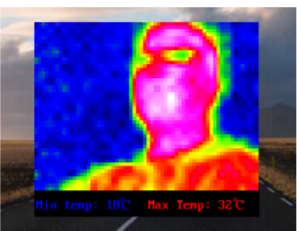
【毕业设计】基于单片机红外热成像仪 - stm32 物联网 嵌入式
Hi,大家好,这里是丹成学长,今天向大家介绍一个非常非常炫酷的单片机项目基于单片机红外成像仪大家可用于 课程设计 或 毕业设计单片机-嵌入式毕设选题大全及项目分享:https://blog.csdn.net/m0_71572576/article/details/125409052红外热成像仪听起来是不是很酷、很高大尚? 它们可以清晰的显示出电路,发动机,管道,房屋隔热中的热量,可以用于消防,医学
文章目录
1 简介
Hi,大家好,这里是丹成学长,今天向大家介绍一个非常非常炫酷的单片机项目
基于单片机红外成像仪
大家可用于 课程设计 或 毕业设计
单片机-嵌入式毕设选题大全及项目分享:
https://blog.csdn.net/m0_71572576/article/details/125409052
2 项目简介
红外热成像仪听起来是不是很酷、很高大尚? 它们可以清晰的显示出电路,发动机,管道,房屋隔热中的热量,可以用于消防,医学,法医,环境科学,搜索和救援,能量监测,化学反应,检测野生生物,检测侵入者中的热量。 它还能做什么? 在您的房子中找到最冷的地方? 微调超频游戏机中的冷却系统? 调查是否有人坐在您的躺椅上? 但是不幸的是这个相机的价格一直使它离我们遥不可及……直到现在。
Adafruit MLX90640红外热像仪突破性解决方案,使低分辨率热成像的成本大幅降低到大众能接受的程度。 它可以检测55度或110度视野内的32 x 24像素温度网格。 借助Adafruit的一些额外功能,您可以将它变成自己的微型热像仪。
3 主要器件
3.1 MLX90640红外摄像头模块

该传感器包含24x32的红外热传感器阵列。 连接到微控制器(或Raspberry Pi)后,它将通过I2C返回768个独立红外温度读数的数组。 就像那些很酷的热像仪一样,但是它紧凑而简单,易于集成。
3.1.1 模块特性
该块一款红外热像仪模块,32×24 像素,I2C 接口通信,兼容 3.3V/5V 电平,支持 Raspberry Pi、
Arduino 等主控。
我采用 MLX90640 远红外热传感器阵列,可精确检测特定区域和温度范围内的目标物体,
尺寸小巧,可方便集成到各种工业或智能控制应用中。
- 采用 MLX90640 远红外热传感器阵列,32×24 像素
- 支持 I2C 接口通信,可设置为快速模式(速率可达 1MHz)
- 噪声等效温差(NETD)仅为 0.1K RMS@1Hz 刷新率,噪声性能好
- 板载电平转换电路,可兼容 3.3V/5V 的工作电平
3.1.2相关参数
- 工作电压:3.3V/5V
- 工作电流:<23mA
- 通信接口:I2C (地址为 0x33)
- 视场角(水平视角×垂直视角):
- MLX90640-D55 Thermal Camera:55°×35° (角度小,适合远距离测量)
- MLX90640-D110 Thermal Camera:110°×75° (角度大,适合近距离测量)
- 工作温度:-40℃~85℃
- 目标温度:-40℃~300℃
- 检测精度:±1℃
- 刷新速率:0.5Hz~64Hz (可编程设置)
- 产品尺寸:28mm×16 mm
- 固定孔尺寸:2.0mm
3.1.2 应用场景
- 高精度非接触性物体温度检测
- 红外热像仪、红外测温仪
- 智能家居、智能楼宇、智能照明
- 工业温度控制、安防、入侵/移动检测
3.1.3 接口说明(以接入 MCU 为例):
- VCC:接 3.3V
- GND:接 GND
- SDA:接 MCU.I2C 数据线
- SCL:接 MCU.I2C 时钟线
4 实现效果
4.1 STM32+LCD 图像显示

4.2 Arduino+ESP32+LCD 图像显示

4.3 树莓派 HDMI 显示屏显示

5 部分相关驱动代码
#include <Adafruit_MLX90640.h>
#include "Adafruit_Arcada.h"
Adafruit_MLX90640 mlx;
Adafruit_Arcada arcada;
#if !defined(USE_TINYUSB)
#warning "Compile with TinyUSB selected!"
#endif
File myFile;
float mlx90640To[768]; // Here we receive the float vals acquired from MLX90640
#define DE_BOUNCE 200
// Wait this many msec between button clicks
#define MENU_LEN 12
// Number of total available menu choices
#define MENU_ROWS 9
// Number of menu lines that can fit on screen
#define MENU_VPOS 6
#define GRAY_33 0x528A
#define BOTTOM_DIR "MLX90640"
#define DIR_FORMAT "/dir%05d"
#define BMP_FORMAT "/frm%05d.bmp"
#define CFG_FLNAME "/config.ini"
#define MAX_SERIAL 999
// BMP File Header, little end first, Photoshop ver.
const PROGMEM uint8_t BmpPSPHead[14] = {
0x42, 0x4D, // "BM" in hex
0x38, 0x09, 0x00, 0x00, // File size, 2360
0x00, 0x00, // reserved for app data 1
0x00, 0x00, // reserved for app data 2
0x36, 0x00, 0x00, 0x00 // Offset of first pixel, 54
};
// BMP 24-bit DIB Header, little end first, Photoshop ver.
const PROGMEM uint8_t DIBHeadPSP1[40] = {
0x28, 0x00, 0x00, 0x00, // Header size, 40
0x20, 0x00, 0x00, 0x00, // pixel width, 32
0x18, 0x00, 0x00, 0x00, // pixel height, 24
0x01, 0x00, // color planes, 1
0x18, 0x00, // bits per pixel, 24
0x00, 0x00, 0x00, 0x00, // Compression method, 0==none
0x00, 0x00, 0x00, 0x00, // Raw bitmap data size, dummy 0
0x12, 0x0B, 0x00, 0x00, // Pixels per meter H, 2834
0x12, 0x0B, 0x00, 0x00, // Pixels per meter V, 2834
0x00, 0x00, 0x00, 0x00, // Colors in palette, 0==default 2^n
0x00, 0x00, 0x00, 0x00 // Number of important colors, 0
};
// BMP file data, 2 byte padding
const PROGMEM uint8_t PSPpad[2] = {0x00, 0x00};
//Byte arrays of bitmapped icons, 16 x 12 px:
const PROGMEM uint8_t battIcon[] = {
0x0f, 0x00, 0x3f, 0xc0, 0x20, 0x40, 0x20, 0x40, 0x20, 0x40, 0x20, 0x40,
0x20, 0x40, 0x20, 0x40, 0x20, 0x40, 0x20, 0x40, 0x20, 0x40, 0x3f, 0xc0};
const PROGMEM uint8_t camIcon[] = {
0x01, 0xe0, 0x61, 0x20, 0xff, 0xf0, 0x80, 0x10, 0x86, 0x10, 0x89, 0x10,
0x90, 0x90, 0x90, 0x90, 0x89, 0x10, 0x86, 0x10, 0x80, 0x10, 0xff, 0xf0};
const PROGMEM uint8_t SDicon[] = {
0x0f, 0xe0, 0x1f, 0xe0, 0x3c, 0x60, 0x78, 0x60, 0x70, 0x60, 0x60, 0x60,
0x60, 0x60, 0x60, 0x60, 0x6f, 0x60, 0x60, 0x60, 0x7f, 0xe0, 0x7f, 0xe0};
const PROGMEM uint8_t snowIcon[] = {
0x15, 0x00, 0x4E, 0x40, 0xC4, 0x60, 0x75, 0xC0, 0x9F, 0x20, 0x0E, 0x00,
0x0E, 0x00, 0x9F, 0x20, 0x75, 0xC0, 0xC4, 0x60, 0x4E, 0x40, 0x15, 0x00};
uint8_t pixelArray[2304]; // BMP image body, 32 pixels * 24 rows * 3 bytes
// Some global values that several functions will use, including
// 5 floats to append to the BMP pixel data:
// coldest pixel, coldest color, center temp, hottest color, hottest pixel
float sneakFloats[5] = {3.1415926, 0.0, -11.7, 98.6, -12.34}; // Test values that get overwritten
uint16_t highAddr = 0, lowAddr = 0; // Append the pixel addresses, too
uint16_t backColor, lowPixel, highPixel, buttonRfunc = 1,
emissivity = 95, frameRate = 4,
thermRange = 0, paletteNum = 1, colorPal[256], // Array for color palettes
nextDirIndex = 0, nextBMPindex = 0, nextBMPsequence = 1; // These keep count of SD files and dirs, 0==error
uint32_t deBounce = 0, buttonBits = 0;
boolean mirrorFlag = false, celsiusFlag = false, markersOn = true,
screenDim = false, smoothing = false, showLastCap = false,
save1frame = false, recordingInProg = false, buttonActive = false;
float battAverage = 0.0, colorLow = 0.0, colorHigh = 100.0; // Values for managing color range
volatile boolean clickFlagMenu = false, clickFlagSelect = false; // Volatiles for timer callback handling
setup()函数首先执行,每次启动仅执行一次。 它的工作是初始化系统,从Arcada代码及其将控制的板载硬件开始,例如屏幕和按钮等。
然后一组测试确定闪存是否准备好接收新的BMP文件。
void setup()
{
if (!arcada.arcadaBegin()) { // Start TFT and fill with black
// Serial.print("Failed to begin");
while (1);
}
arcada.filesysBeginMSD(); // Set up SD or QSPI flash as an external USB drive
arcada.displayBegin(); // Activate TFT screen
arcada.display->setRotation(1); // wide orientation
arcada.display->setTextWrap(false);
arcada.setBacklight(255); // Turn on backlight
battAverage = arcada.readBatterySensor();
Serial.begin(115200);
// while(!Serial); // Wait for user to open terminal
Serial.println("MLX90640 IR Array Example");
if(arcada.filesysBegin()){ // Initialize flash storage, begin setting up indices for saving BMPs
if(!arcada.exists(BOTTOM_DIR)) { // Is base "MLX90640" directory absent?
if(arcada.mkdir(BOTTOM_DIR)) // Can it be added?
nextDirIndex = nextBMPindex = 1; // Success, prepare to store numbered files & dirs
} else { // "MLX90640" directory exists, can we add files | directories?
// Get the number of the next unused serial directory path
nextDirIndex = availableFileNumber(1, BOTTOM_DIR + String(DIR_FORMAT));
// and the next unused serial BMP name
nextBMPindex = availableFileNumber(1, BOTTOM_DIR + String(BMP_FORMAT));
}
} // By now each global index variable is either 0 (no nums available), or the next unclaimed serial num
单片机-嵌入式毕设选题大全及项目分享:
https://blog.csdn.net/m0_71572576/article/details/125409052
6 最后
更多推荐
 已为社区贡献17条内容
已为社区贡献17条内容







所有评论(0)